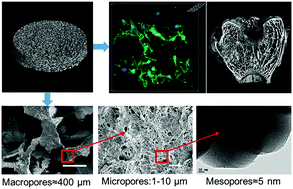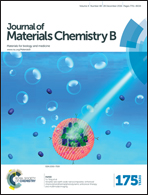Effects of magnesium silicate on the mechanical properties, biocompatibility, bioactivity, degradability, and osteogenesis of poly(butylene succinate)-based composite scaffolds for bone repair
Abstract
Bioactive scaffolds of magnesium silicate (m-MS)/poly(butylene succinate) (PBSu) composites were fabricated by a solvent casting–particulate leaching method for bone regeneration. The scaffolds had a hierarchical porous structure with interconnected macropores (300–500 μm), micropores (1–10 μm) and mesopores (∼5 nm). In addition, the composite scaffolds were degradable in Tris-HCl solution and formed apatite on their surfaces in simulated body fluid, indicating good degradability and bioactivity in vitro. Compared with PBSu scaffolds, the composite scaffolds improved the in vitro attachment, proliferation and osteogenic differentiation of MC3T3-E1 cells, revealing good cytocompatibility. Furthermore, the model of rabbit femur cavity defects was used to evaluate the in vivo osteogenesis of the composite scaffolds. The results of synchrotron radiation-based mCT (SRmCT) imaging, histological analysis and immunohistochemistry showed that the composite scaffolds were gradually degraded and replaced by new bone, and the scaffolds with 40 wt% m-MS (C40) almost completely disappeared after 12 weeks of implantation, indicating that the scaffolds containing m-MS enhanced new bone formation. The results demonstrated that the bioactive m-MS/PBSu composite scaffolds with good biocompatibility, degradability, bioactivity and osteogenesis are promising biomaterials for bone repair.


 Please wait while we load your content...
Please wait while we load your content...